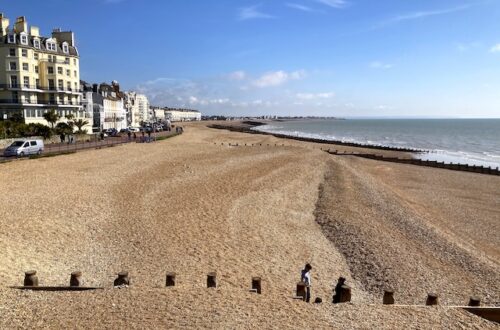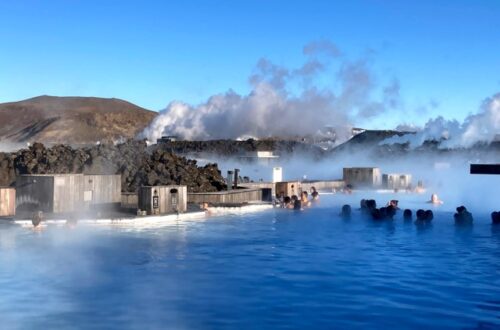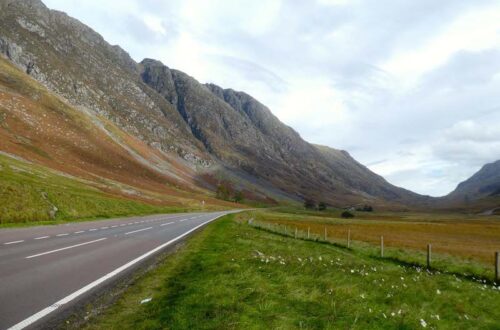
Euskadi – And The Wonderful Cities Of San Sebastian and Bilbao
Photographs by Mike Vickers and Jan Jones
Feature Photo above: San Sebastian and the glorious curve of La Concha from Monte Igueldo
Sunday, and because we needed to be at Gatwick Airport for an early morning Monday flight, we caught the coach from Gloucester, changing at Victoria, and arrived in plenty of time to have an evening meal before a good night’s sleep at the Gatwick Travelodge.
Other airport hotels are available. Lots of other airport hotels…
So, bright-eyed and bushy-tailed, we took the 6am shuttle bus to the South Terminal. Easy-peasy. The formalities proved to be no problem, then we were away, climbing swiftly through low foggy cloud until we burst out into bright morning sunshine like a missile launched from a submarine.
This is why pilots sport the best tans of any profession, even more so than the owners of tanning studios!
After a surprisingly bumpy flight of two hours, and having passed over Jersey basking in full sunshine, we landed in Bilbao, the largest city in Euskadi, the Basque country. This unique historic area straddles the border between north-eastern Spain and south-western France and is where you can still hear people speaking the oldest living language in Europe, Euskera, which dates back to the Neolithic period. It’s considered a language isolate, meaning it has no connection with any other language, and had already been around for several millennia before that upstart newfangled Latin appeared on the scene. Yes, people have been living here for an awfully long time.
The terminal building at Bilbao was very swish, like a spaceship from Star Trek. Once through, we were met by Quino, our driver, and ushered to his lovely black Mercedes. I’ve never been in a Mercedes before. It was very nice. We negotiated a bewildering number of motorway junctions, following a lovely route along narrow valleys and through many tunnels at a brisk pace.
A very brisk place. I’m not kidding, we seemed to be flying just as fast as the jet!
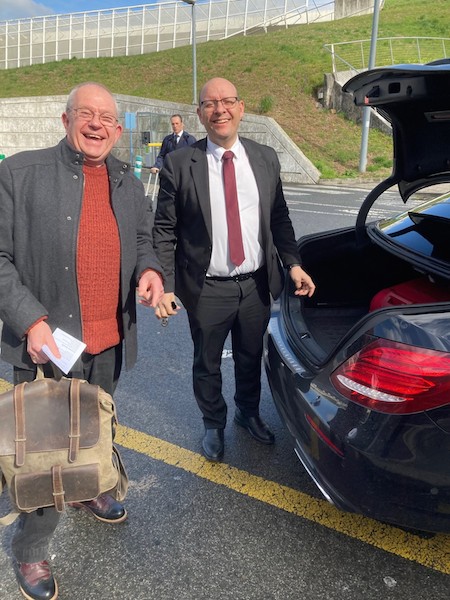
Before very long, it began to rain heavily and continued to do so until we reached San Sebastian, also known as Donostia in Euskera, and pulled up at the hotel. After booking in, we went up to our room where I discovered to my horror that in the general haste to exit the car, I’d left my hand bag behind on the back seat. Well, it’s not quite a hand bag in the traditional sense, more of a stylishly travel-worn Indiana Jones-style leather man bag that I hang with cool panache over one shoulder and which contained my wallet, emergency KitKat chocolate bar, two cameras and most importantly, the keys to my suitcase – and our front door key. Oh, and after persistent petitioning by Jan over a considerable number of years, a small packet of tissues.
Fortunately, to my relief, Jan was able to contact Quino and he returned in short order to hand over my bag. The traffic was constant outside the hotel so he could only stop for a few moments in his expensive black limo, and as I gave him a tip for his trouble, it struck me that to any casual onlooker this swift transaction had all the hallmarks of a dodgy street deal!
Our home for the next five days was the Hotel Codina, located on a main route leading to La Concha Bay and its curving promenade, but with our room at the rear, we did not suffer any traffic noise. After unpacking – at least now I could actually unlock my case – we headed out for a bite to eat. The receptionist recommended Bar Pepe, a few blocks down the road towards the bay, so we checked it out.
This was a local’s cafe and bar that offered a good menu in Spanish. Unsurprising when you considered we were in Spain, but as we struggled to identify some of the dishes and ingredients, our waitress returned and with a sympathetic grin and handed over another menu, this time in English.

Matters proceeded at a much more lively pace after that. Jan decided on two pintxos dishes, one of scallops, the other prawns, and I had a crispy chicken salad. Pintxos are small servings, much like tapas, and the town is renowned across Spain for its pintxos culture. The cafe around us was lively with flowing conversations while dishes were brought out continuously. It was all really rather lovely.
With our appetites satiated, we strolled down to La Concha and had a short amble along the prom. The Atlantic rolled in, waves washing up the golden yellow sand. The town stretched all the way around the curving bay and snuggled up to a headland at either end, while the small Isla de Santa Clara lay just offshore between these two lumpy promontories.
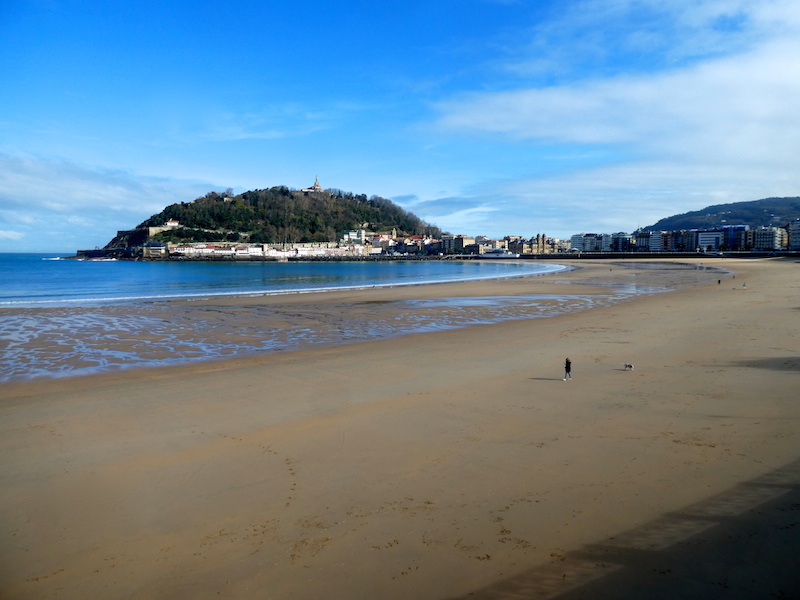
The seafront park was very attractive and filled with gnarled tamarisk trees, obviously of considerable age and pollarded back to bare knobbly knuckles. Many were only able to support their aged limbs with ropes and slings.
I know how they feel.
An information board revealed these venerable trees had been planted in the late 19th century, and over the years have become a famed feature of the city. With it being March, they were still asleep, but by all accounts they are beautiful in the summer.
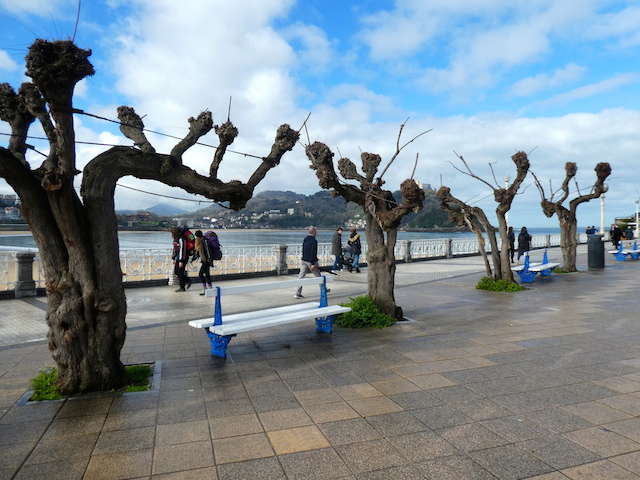
That evening, as the light failed, we stepped out again and walked along the prom into town. Fortunately, a light rain came to nothing while we explored, but we did buy an umbrella just in case, knowing that the act of purchasing one almost certainly now guaranteed there will be no more rain for the rest of our stay. It’s like washing the car to encourage a torrential downpour, but in reverse.
There’s no doubt San Sebastian is an exceptionally attractive city, comprising many splendid buildings and churches, with elegant tree-lined boulevards and squares. By this time, most of the shops were closing up, but the evening’s socialising was just getting going and the locals were out in force. After our late lunch, we were not hungry enough for a full meal but certainly peckish enough for something lighter and settled for a coffee and pastry, then took a short bus ride back to the hotel and bed.
The following morning, after a simple but tasty cold buffet breakfast at the hotel, we headed out again, exploring some of the back streets behind the hotel before strolling along the sea front into town. The tide was out, revealing a broad sandy beach beloved by dog walkers and hardy swimmers. Although we started out in drizzle, by the time we reached the city centre, the sun was putting in an appearance, and the weather continued to improve all day.
Told you buying the magic umbrella was a sure fire bet!
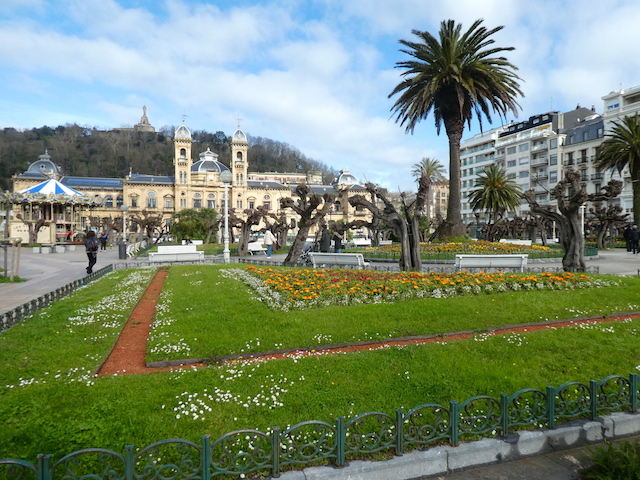
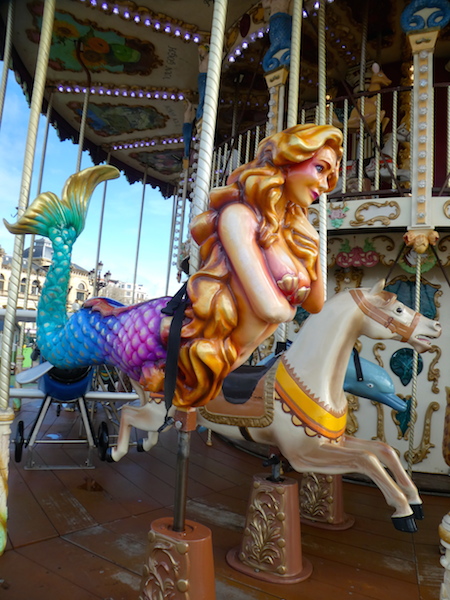
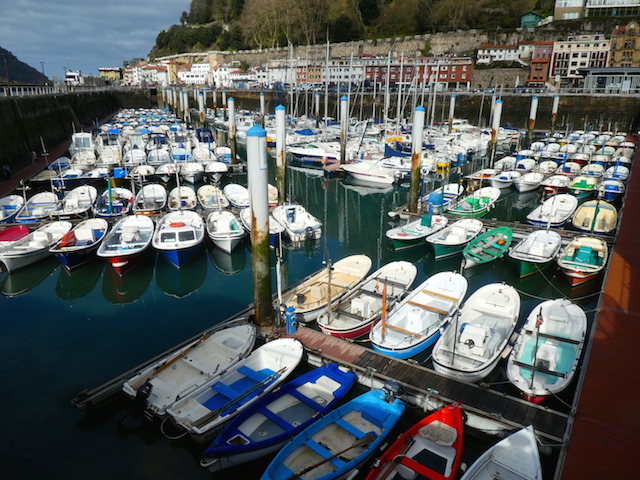

We explored around the modest harbour and the back end of the Parte Vieja, the Old Town, then went to meet our guide for a pre-arranged pintxos and wine tasting tour. The meeting point was at the elegant Art Nouveau wrought iron and stained glass oval bandstand at the centre of town, but when we turfed up we found a large gathering of several thousand flag-waving political demonstrators busily rendezvousing in the same place. With no hope at all of identifying our guide in the crowds, we retired to a nearby coffee shop for a latte.
‘Don’t worry,’ I said to Jan, ‘this lot will soon be off.’ Sure enough, ten minutes later the crowds – with their banners, kids, dogs and infants slumbering in prams – had all ambled away in a very relaxed and genial interpretation of a protest march under the gaze of a pair of bored policewomen, and as we were the only people left anywhere near the bandstand at the allotted time, Fabian, our guide, figured out who we were with no difficulty whatsoever.
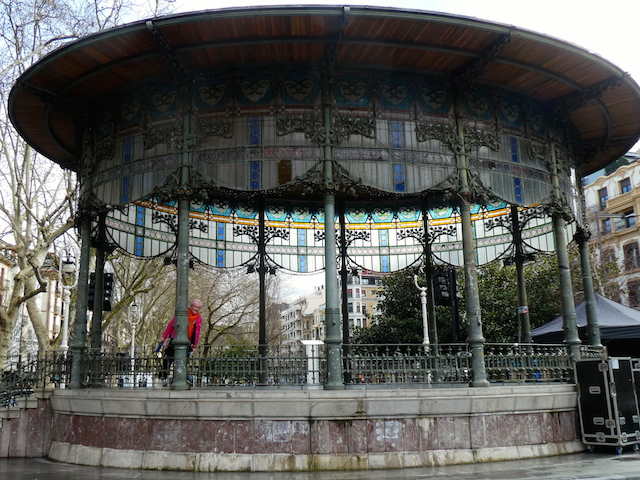
With no other customers, he cheerfully announced we would be getting a personal tour, and that suited us down to the ground. We dived back into the Parte Vieja and spent the next couple of hours visiting a total of five pintxos bars, savouring a variety of delicious dishes, including octopus, steak skewers and sweet crab meat. Fabian proved a genial host and font of all knowledge.
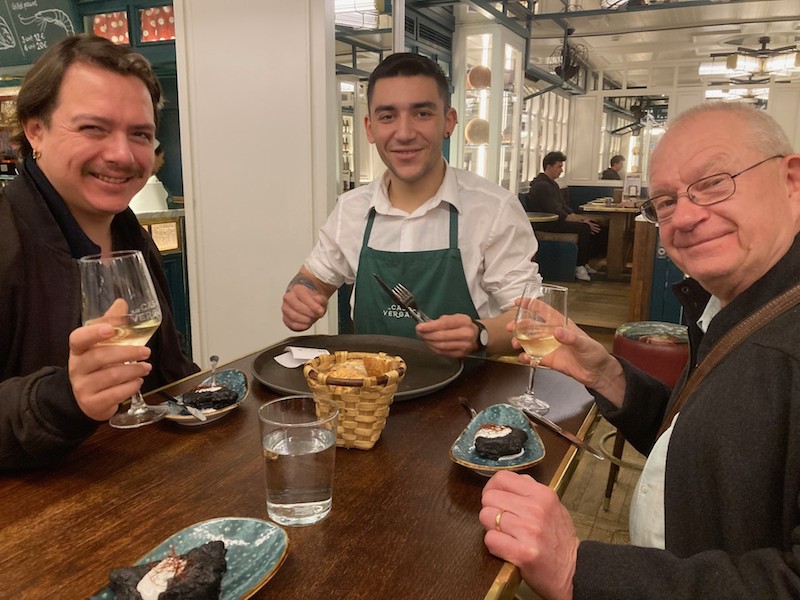
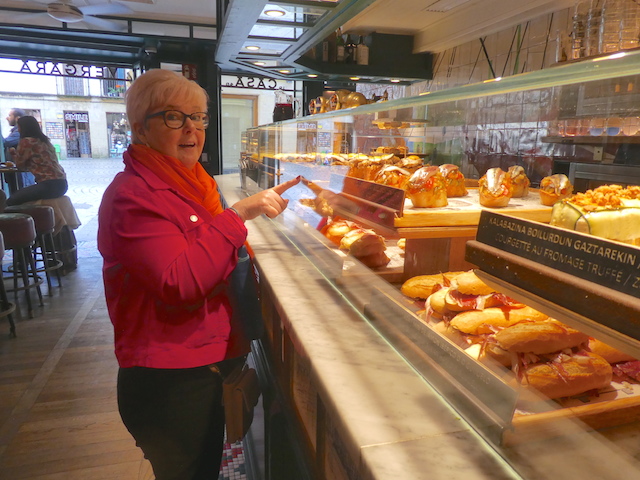
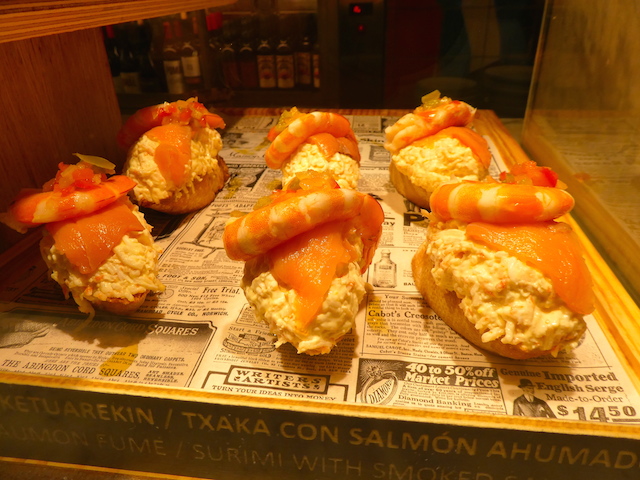
As for the wines, well, we had local cider at the first stop, then wine, but also, thankfully, water and coffee. Those who know me well will tell you I cannot take my drink, and even a few extremely modest glasses of wine would result in my deeply slumbering body being scooped up from a nearby gutter by council workmen the following morning, and that was a fate that I – and particularly Jan – were both keen to avoid.
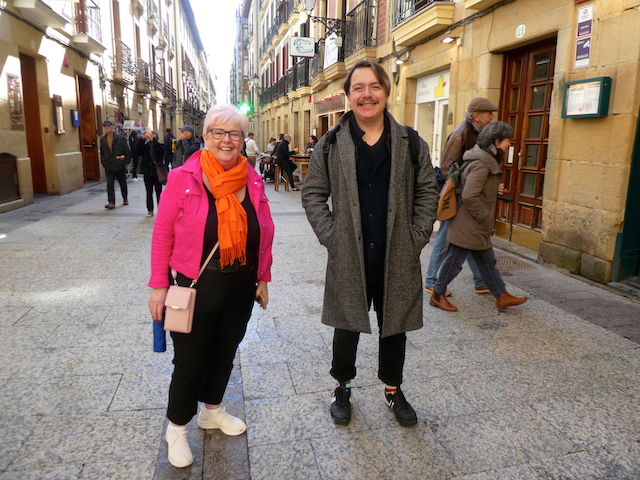
We enjoyed our time with Fabian very much and after departing mid-afternoon, decided we’d like to finish our most pleasant exploration with a delicious San Sebastian cheesecake, so we returned to a bar we’d passed earlier. Jan ordered, but something got lost in translation and instead we ended up with a plateful of sliced cheese with quince jam and bread.
It was very nice – but not as nice as San Sebastian cheesecake. Our quest continues…
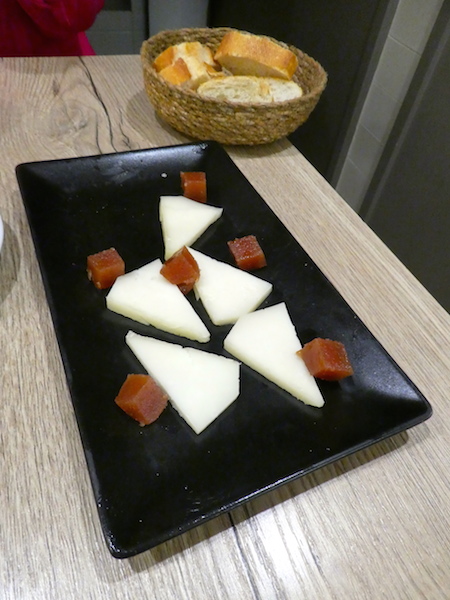
After breakfast the following morning and with our magic umbrella having summoned up a bright, sunny day, we decided to explore the other end of the bay. So, on reaching the prom, instead of turning right toward the city centre we turned left and headed in the opposite direction towards the steep headland of Monte Igueldo.
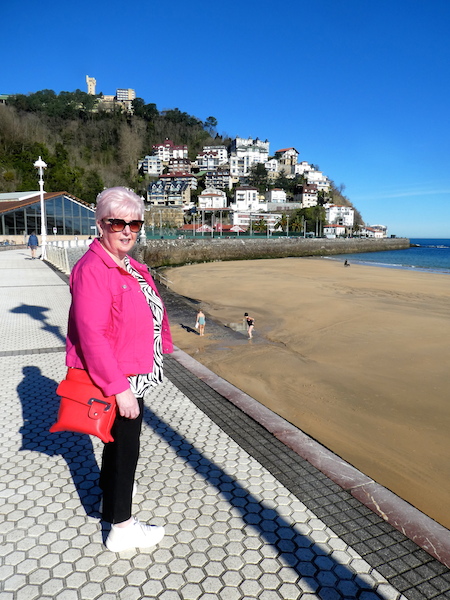
With the tide well out, the beach proved irresistible to dog walkers and determined swimmers. Yes, in the sun the temperature was very acceptable, but this was the North Atlantic, for heaven’s sake. You know, where the Titanic sank after hitting something very large and very solid.
Not for us, I’m afraid. We like our sea temperatures in the upper 20s, thank you very much, and anything less will fail to tempt either of us out of our shoes and socks let alone into our swimming costumes
We walked as far as the path would allow, ending up under a cliff where three large abstract steel sculptures were fixed to the rocks. Known as El Peine del Viento, or The Wind Comb, these were currently well out of the water, but when the weather turns rough, waves actually crash through the sculptures, combing the combers so to speak.
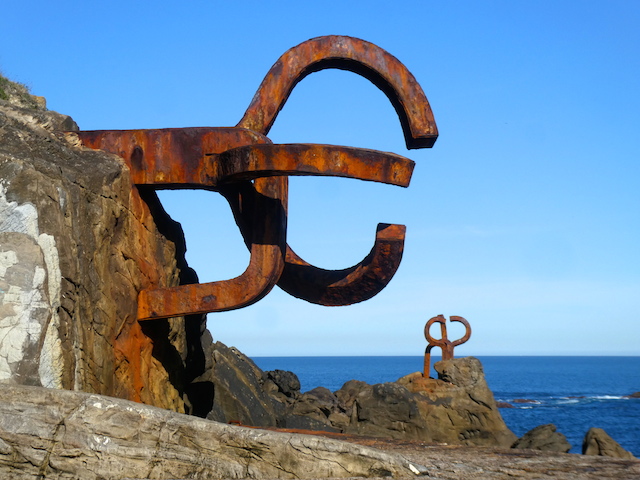
By this time, the beach had really begun to bustle. An elderly gentleman hobbling on crutches went for a paddle, crutches and all, while throwing a ball for his exuberant Jack Russel terrier to retrieve. Then a school party arrived, out on a morning’s excursion. Comprising about twenty young children of maybe three or four years old and watched over by three teachers, they were all terribly excited and drew hearts in the wet sand before racing away to peer at something wondrous in a rock pool at the foot of the sea wall – and that was just the teachers!
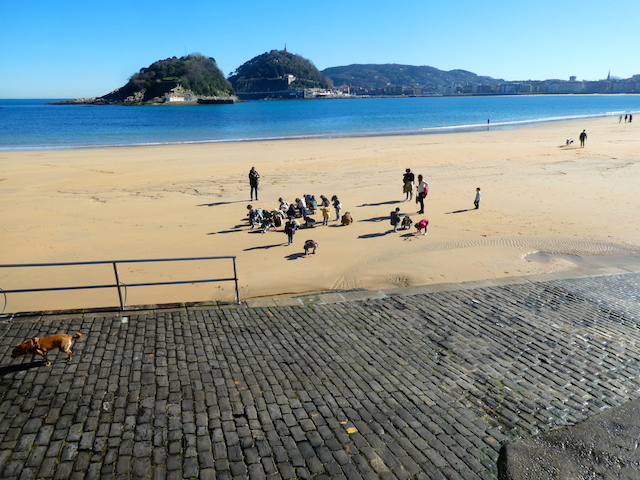
We watched for a while before wandering off to the funicular railway that ascended to the summit of Monte Igueldo. This was a lovely old-fashioned machine with cable-pulled wooden carriages that ran up and down an impressively steep incline at a very stately pace. I have to say the views from the top were really lovely, with the whole of the city laid out around the glorious curve of La Concha beach, while inland we could see some of the higher peaks were still capped with winter snow.
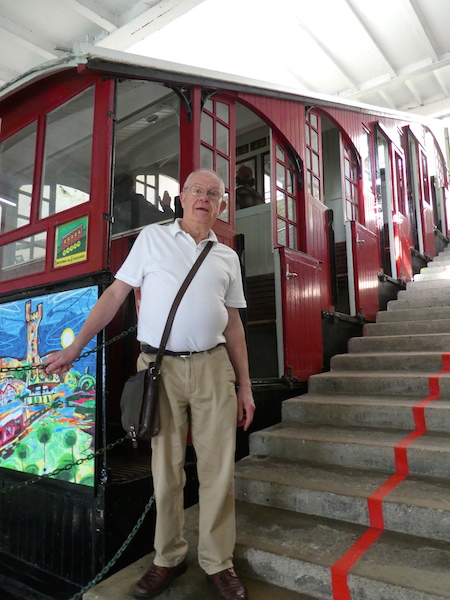
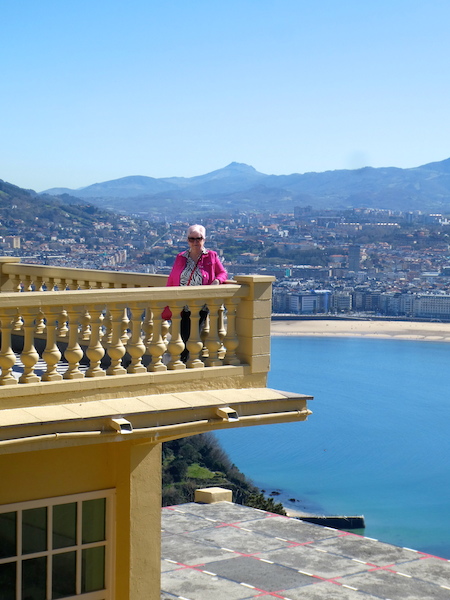
Descending on the funicular again, we caught a bus into town and went in search of some lunch, threading our way through the Parte Vieja to Casa Vergara, one of the restaurants we visited yesterday with Fabian. Perched around a high table, we enjoyed some really tasty pintxos. Jan’s were fish-themed, her favourite, while mine were cheesy or mushroomy, and we followed these up by walking around to nearby La Vina where we finally managed to have our first San Sebastian cheesecakes.
It was well worth the wait – they were smooth, creamy and totally delicious. No idea what the calories were and didn’t care.
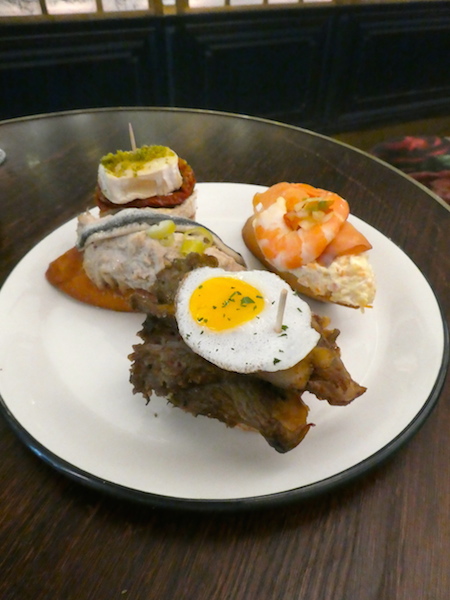

Now nicely satiated, a stroll took us down to the mouth of the Urumea River adjacent to the city centre and we spent a very pleasant hour or so sitting in the sun outside the Argitan coffee shop watching the world walk by, a pastime we both enjoy very much.
Amongst many, we observed youngsters riding on electric scooters wearing headphones so they couldn’t hear the horns of the trucks that were about to mow them down, lots of leisurely cyclists out enjoying the bright spring weather, an elegantly dressed lady wearing shoes Jan would’ve killed to own, quite a few wetsuit-clad twenty-somethings carrying their surf boards to and from the beach, and one spectacularly tall beauty strolling along arm in arm with her much shorter but probably richer boyfriend.
There’s all the world to see if you just take time to stop and watch.
That evening, we ventured out for supper at Cafe Pepe, our closest eatery, where we had crab-based pintxos and a glass of white wine, both very acceptable. The stroll home was along a back street teeming with life. People milled around bars or sat eating at pavement tables. Most shops were still open and many locals were making their way home sporting their evening baguette.
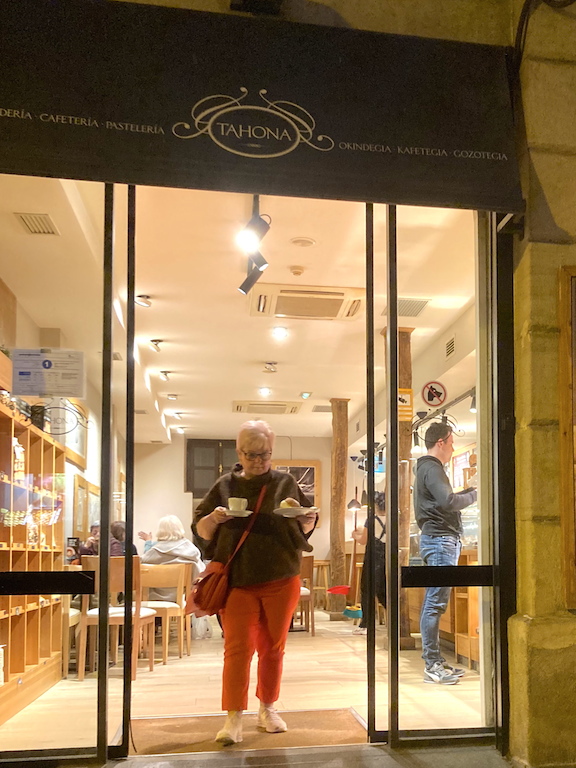
We stopped for coffee and cream buns – it’s been clinically proven that holiday cholesterol does not fur up the arteries – and soaked up the relaxed communal atmosphere, such pleasant conviviality no doubt greatly encouraged by the lingering warmth of the sunny day. You can thank the magic umbrella for that.
While we were on our pintxos and wine excursion the other day, Fabian strongly recommended a visit to Hondarribia, east of San Sebastian and the last Spanish town before you hit France, so that was what we did after breakfast the following morning. The bus took about half an hour to complete the journey, including a stop at the local regional airport, and on the way we passed a surprising number of allotments on either side of the road. Now there’s something I really didn’t expect to see. Who knew the Spanish had an allotment culture? Anyway, we definitely knew we’d arrived in Hondarribia when the driver pulled up and turned off the engine, the globally accepted indication that you’d reached your destination.
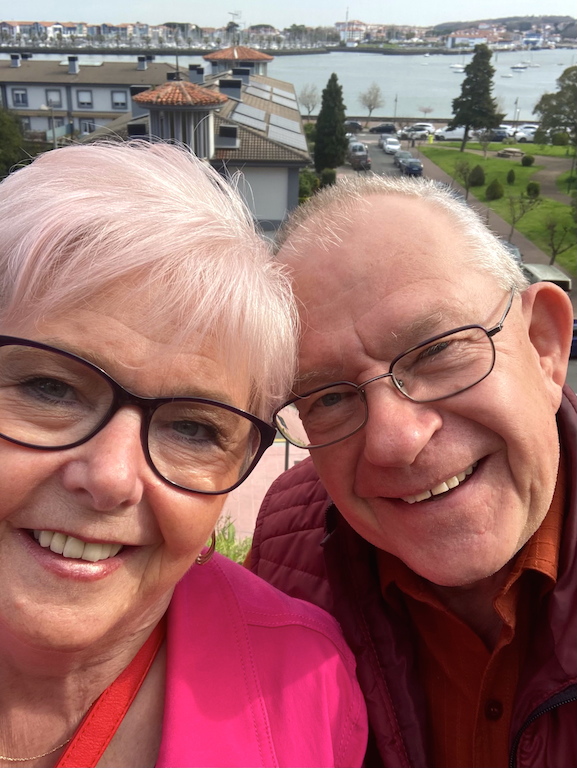
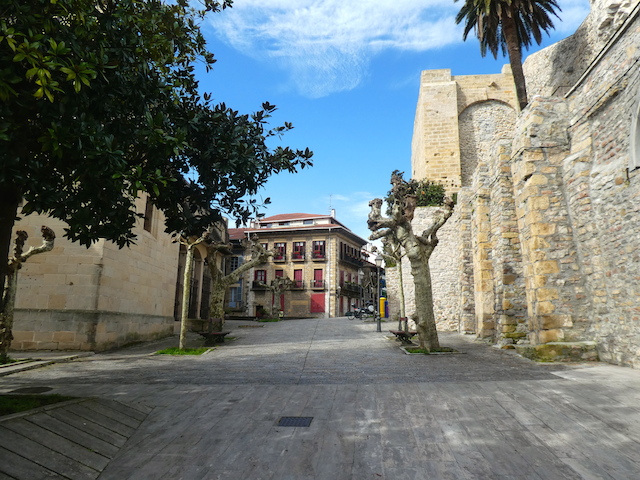
Hondarribia sits on one side of a river estuary and France sits on the other, with a modest passenger ferry connecting the two. The historic old quarter was a compact medieval town protected by chunky grey walls peppered with the occasional bastion. The cobbled streets were narrow and the lovely buildings tall, with ornate façades and overhanging eaves. Many had been restored and were obviously well maintained.
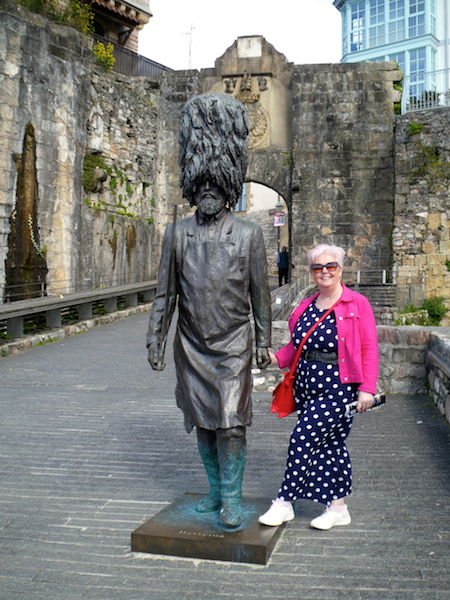
We stopped for refreshments in Arma Plaza, the square in front of the businesslike parador of Charles V before embarking on an impressively aimless amble of Olympic quality. By this time the sun had come out, adding to the sense of general enjoyment, which was then further enhanced by another pause for a glass of cold local white in Gipuzkoa Plaza. This proved very agreeable – and amusing. The bar toilets were not identified using any written language, but there was no doubting where each gender had to go, as you can see from the photos!

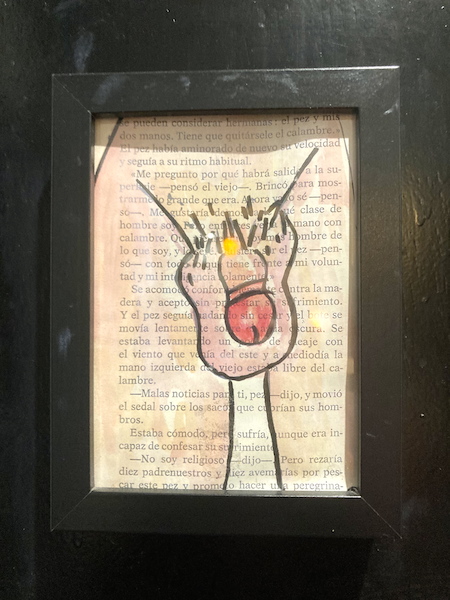
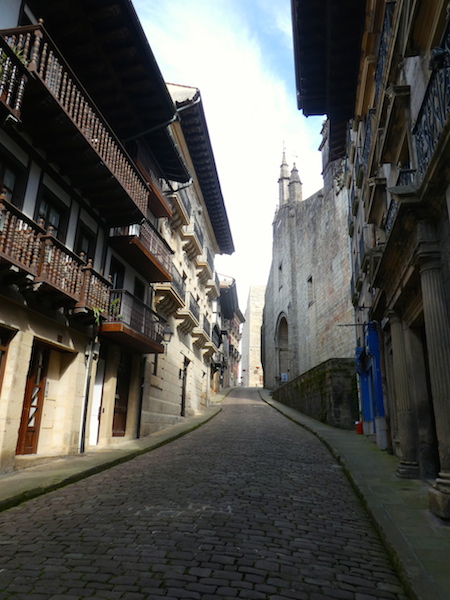
On leaving the old quarter, we explored the rest of town. They’re big on plane trees in Hondarribia, and many lined the pedestrianised streets, all pollarded to within an inch of their lives. It was like an arboreal version of the US Marine Corps haircut!
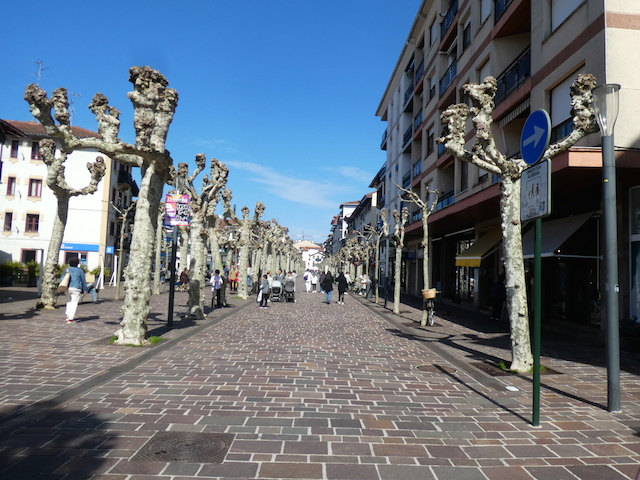
We stopped for a pintxos lunch – not that there’s really any other kind around here – and were entertained when the local policeman arrived and made the cafe owners move their outer row of tables back behind an invisible line, including tables which were currently occupied by diners, who all of whom had to pick up their dishes and retreat to a police approved area.
Apparently, unauthorised table expansion is severely frowned upon in Hondarribia.
On the way back to the bus stop, we strolled down to the river, the actual border between Spain and France. I think this is only the second time I’ve ever photographed Jan with two countries in the background, the other being our visit to the ruined city of Ani in the extreme east of Turkey, with Armenia on the far bank of the Arpaçay river. You can see the photo in my article on Kars.
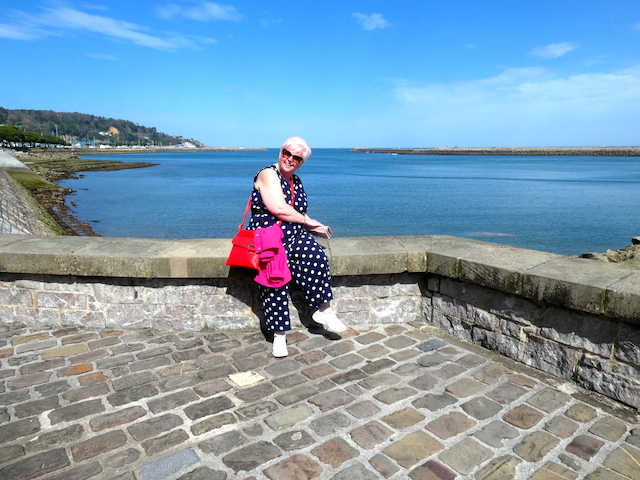
Mid-afternoon found us back once more at the Argitan, where I relaxed with a coffee while the warm sun finally raised the temperature to a level that activated Jan’s ice cream trigger. Yes, I can safely say San Sebastian is a really lovely city made even more attractive when the sun shines.
After breakfast the following morning and with the pleasant weather still under the control of our magic umbrella, Jan stopped off at a nail bar for a tidy up, giving me a free hour to go visit the nearby Palacio de Miramar, a splendid cliff-top holiday retreat built in the late nineteenth century for Maria Christina of Austria, consort of Alfonso XII of Spain, who had developed a great liking for San Sebastian. This lovely building is in the English style and sits in splendid gardens of lawn shaded by many mottle-trunked plane trees.
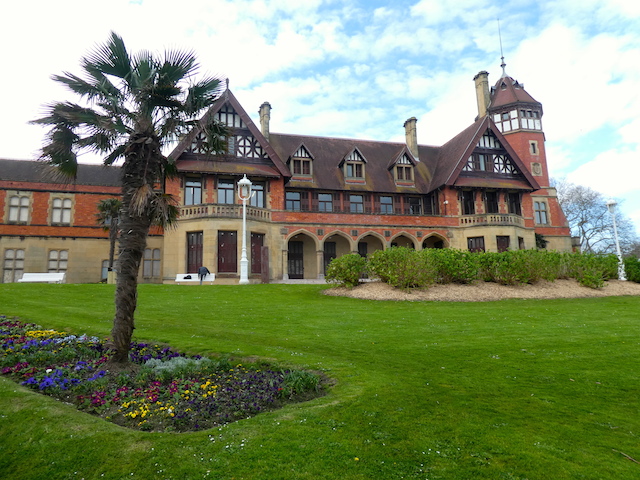
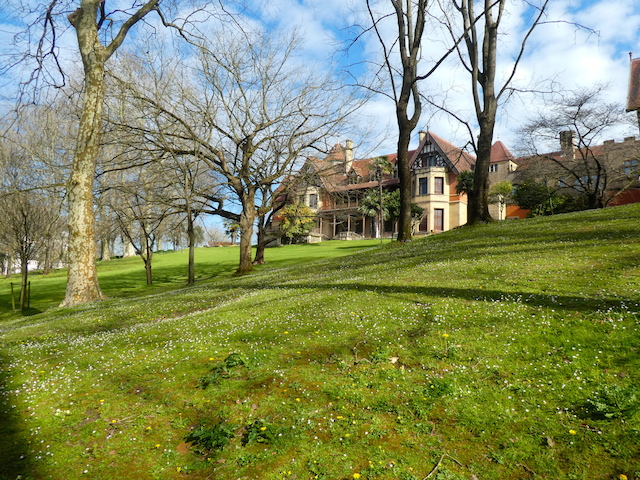
I spent a very enjoyable time wandering around the grounds before rejoining Jan and we walked into town, exploring some of the main shopping boulevards behind the seafront before stopping for a sit down in the square by the bandstand. This naturally took us to lunchtime, so it was pintxos again at our new favourite spot, the Casa Vergara, where we were able to secure a table at the back after threading our way through the busy crowds.
Sated, we aimed for the best people watching spot in town – the Argitan – where we contributed to their daily takings with a gelato each while sitting in the sun. Well, someone has to, before returning to the hotel for our usual late afternoon rest.
That evening, we popped out for a coffee and cake in one of the several bakeries on the back road behind the hotel. Jan had a mini pepito, a small filled dumpling and I had an almond and cream tart. With it being Friday night, the street was crowded, with plenty of strollers and customers enjoying a drink or two outside the bars and cafes. It was all quite lively and the most popular establishments could be identified by the size of the crowd spilling out onto the pavement.
The next morning, with our time in San Sebastian coming to an end, we had our final breakfast at the Codina, packed and vacated our room, and leaving the cases in reception, strolled down to La Concha beach and sat in the shade of one of those famous tamarisk trees watching the locals go about their Saturday morning rituals. Some went for a jog which, as far as we could tell, was approached with varying amounts of enthusiasm, while others enjoyed a swim. Families brought their toddlers down for a play in the sand and, of course, there were dogs of every size and description enjoying fun with their owners, also of every size and description. What a pleasurable way to spend an hour or so.
We returned to the hotel at midday where Iñaki was waiting with his Mercedes minibus, and we left San Sebastian for Bilbao, arriving about an hour later at our hotel after encountering a bewildering number of junctions and tunnels, none of which fazed Iñaki.
Our room at the Illunion San Mamés enjoyed views over the city’s football stadium, but we could also see the countryside just beyond, with hills, forests and fields. As we were using the lifts, several men emerged with their bicycles, which seemed a little odd on the sixth floor. More on that later.

After settling in to what was, actually, a very modern and stylish room indeed, we decided to go for a walk to check out the local neighbourhood, and after negotiating some impressively wide tree-lined boulevards, ended up at a pizza house.
Guillermo, the charming young waiter and good English speaker, helped us with this new-fangled modern way of ordering via a QR code app or some such over-technical bollocks, a procedure which caused no problems for the rest of his young and hip clientele. Honestly, we were several generations older than everyone else and our presence must have raised the average age of customers to at least twenty! However, the pizzas were delicious, and that’s what really mattered. Mine had hard cheese flakes with crushed pistachios and thinly sliced roasted peaches, while Jan had smoked salmon with rocket.
There wasn’t a tomato in sight – and both pizzas were better for it!
Later on in the evening, I peered out of the bedroom window to see great crowds streaming into the stadium over the road. Bilbao were playing Deportivo Alavés in a critically important super competitive and passionately noisy local derby. I’m sure it was absolutely thrilling, but Jan and I were born without the sport gene so we had a cuppa and turned in early. Thank heavens for double glazing.
I’m a man of a certain age, which means I have a much reduced bladder endurance, resulting in occasional midnight micturition, so imagine my surprise when, reaching the darkened bathroom and stealthily approaching the pan so as not to wake Jan, my cautious approach activated a soft night light from behind the pan itself, designed to guide me to my destination. I was mightily impressed. Never seen anything like that in the UK – there are occasions when I think we’re floundering around in the dark ages. Literally!

We only had one full day in the city and so after breakfast, took the tram around the edge of the modern centre, following the gentle curve of the Nervión river to the Opera House, where we met Beatriz, our city walk guide. Luckily, as with Fabian back in San Sebastian, we were the only people on this tour, so the three of us spent the next couple of hours enjoying a very informal stroll around the Casco Viejo, the Old Quarter of Bilbao.

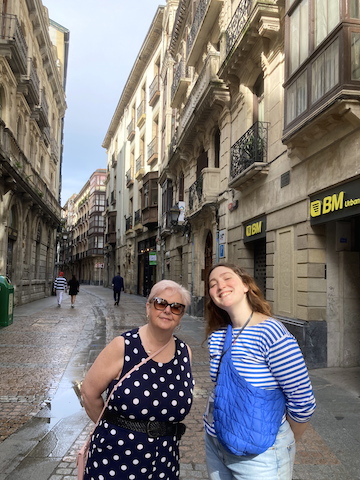
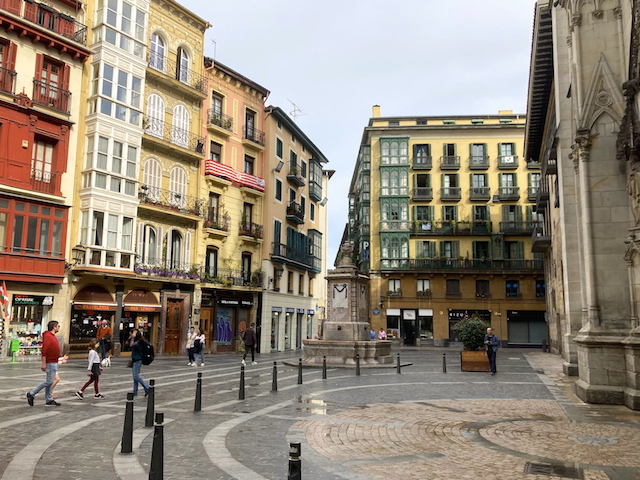
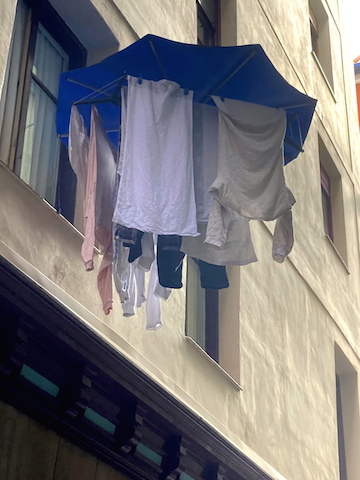
There was nothing Beatriz did not know about Bilbao. We wandered the narrow streets, all lined with tall buildings covered in balconies, visiting squares, churches and various other places of interest, such as Simon Bolivar’s house, he who lent his name to the country of Bolivia. His home is now an Airbnb. Wonder what he’d make of that! We eventually meandered down to the site of the very first bridge ever built in Bilbao at the lowest crossing point of the river before walking back to our starting point in front of the Opera House.

Beatriz was lovely and we enjoyed her company very much. She left us in Plaza Nueva, now bustling with locals out for a Sunday morning stroll. Teams of school kids competing against each other in what looked like mini Olympics in the middle of the square, cheered on by their watching parents. The place was filling up fast as restaurants opened for lunch – and we joined them, enjoying a generous plate of pintxos, with sangria and wine.

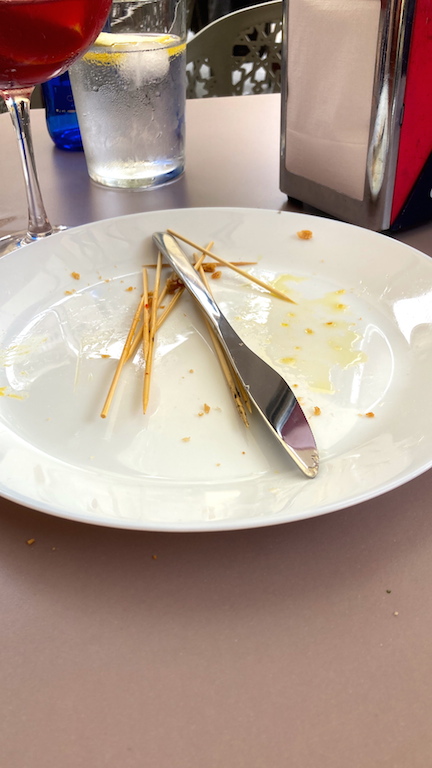
Once full of lunch, we walked back to the hotel right across the city centre, and quickly ran into some cyclists. Actually, a lot of cyclists, certainly the best part of a thousand, who had just completed an annual road race. In fact, the stragglers were still crossing the finish line as we walked past. The place was heaving with tight lycra and bulbous, barely disguised genitals, which Jan found a trifle discombobulating, and every one of those bikes was a racing thoroughbred and worth a lot of money, so I reckoned we were looking at millions of pounds worth of kit. I then remembered the men and their cycles in the lift at the hotel – no wonder those guys were taking their bikes to bed with them!

We finally got back to the hotel mid-afternoon and rested our weary feet. God knows what our step count will be by the time we get back to Gatwick – considering this is supposed to be a relaxing holiday, we’ve really been hammering the shoe leather on this one.

We still had a free morning before the taxi was due mid-afternoon to take us back to the airport, so after breakfast we walked to the Guggenheim Museum, the one standout internationally known institution in Bilbao. It was a lovely day, thanks to the enduring influence of the magic umbrella, so we strolled through several very lovely tree-filled parks on our way down to the river, and there it was, Frank Gehry’s startling masterpiece, its titanium surfaces shimmering in the bright sunshine. I think “shimmering” was what he was aiming for, to be honest.
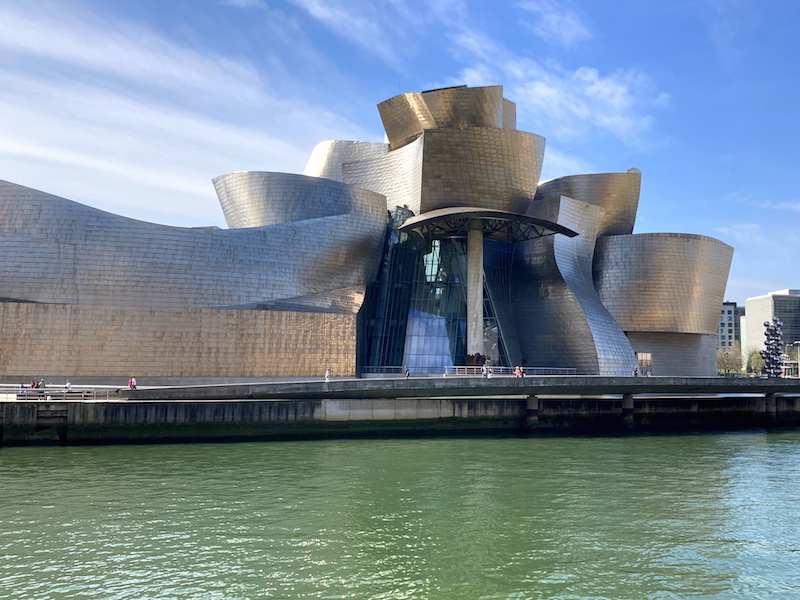
Now, here was a man who obviously had a difficult relationship with right angles, flat surfaces and vertical walls. This truly wonderful building jutted out at all angles, like a haphazard jumble of silver foil-wrapped chocolate bars left out in the sun to melt. There wasn’t a straight line in sight! I love architecture and buildings, regarding them amongst the highest manifestations of human creativity, and this one was truly magnificent, rightfully earning its place as one of the most recognized and acclaimed structures on the planet.
Mind you, the giant spider outside was also pretty amazing!
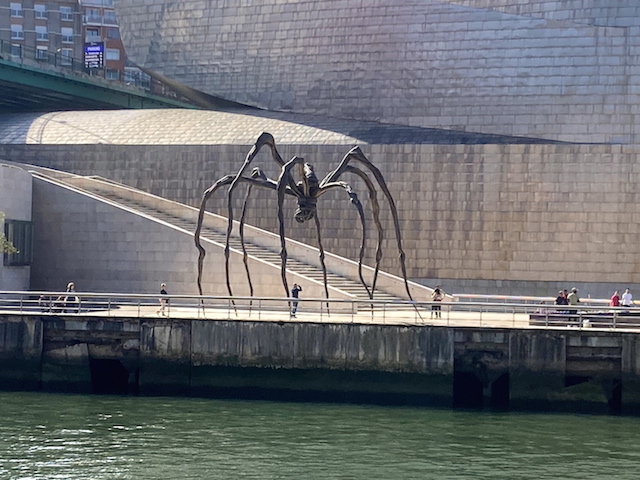
It was shut on Mondays and that was a good thing because although we thought the building was truly astonishing, both Jan and I have a bit of a problem with modern and contemporary art, so that saved us getting kicked out by security for openly scorning the insipid weirdness inside. Funnily enough, we weren’t the only ones who felt that way – our hotel receptionist confided that although structurally impressive, it was rubbish inside. That made us feel much better.

That’s the thing about art – everyone has their own opinion and no-one has the right to tell you you’re wrong.
By this time, we needed to make tracks back to the hotel, where we collected our cases and welcomed the arrival of our taxi, driven assertively by a charming but very determined gentleman from Cuba, of all places. The world really is a wonderful melting pot.
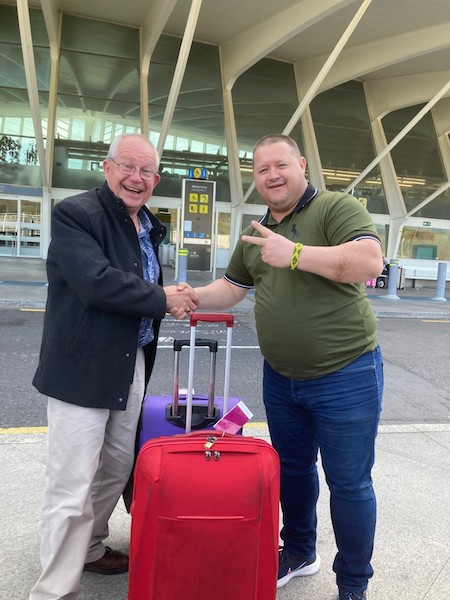
We passed through the airport terminal with no problems, but then something remarkable happened. Once everyone was on board and the engines were fired up, we set off going forwards instead of backwards, the first time in all the years I’ve been flying that this has happened. Normally, as anyone who has ever flown knows, planes are pushed backwards from the boarding tube, but not this time. We started rolling forwards, executed a smart ‘U’ turn to avoid re-entering the terminal building, taxied straight to the end of the runway and promptly took off, all in one smooth manoeuvre.
We winged our way uneventfully back north to Gatwick, landing in the dark, and after an overnight stay in the Travelodge, took the early bus back up to London and then home to Gloucester. Inevitably, it began to rain.
Sadly, our foreign magic umbrella had no power in the strange and chilly land of Britain.
Do you know, we had a really lovely time. It was great, but from the moment we landed in Spain to the moment we left, apart from those pizzas in Bilbao, we did not eat a single cooked meal. It was pintxos all week for us. Tasty, delicious pintxos – but boy, did my tummy struggle.
Notes:
All prices below were correct March 2024.
On The Buses:
Hotel Codina to city centre, 10 minutes, 1.85 euro per person each way.
San Sebastian to Hondarribia, 30 minutes, 2.75 euro per person each way.
On The Funicular up Monte Igueldo:
4.50 euros per person return.
On the city tram in Bilbao:
1.5 euros per person per journey.
On Foot:
Total holiday step count, as verified by iPhone Health App: 92256.
This equates to about 62km, about the distance from our home town of Gloucester to Trowbridge in Wiltshire. Not bad at all for a pair of exercise averse pensioners!
Important Disclaimer: A step count of this magnitude automatically and entirely absolves the steppers from experiencing all feelings of guilt in addition to any possible medical consequences, including, but not necessarily limited to, extreme post-meal lethargy, persistent intestinal gas, abnormal digestive transit, pyrosis, abdominal bloating, congestion or any other temporary or long-term debilitation or distress specifically caused by excessive consumption of pintxos, patatas bravas, tortillas, magnificent Manchego cheeses, nachos, scrumptious cured meats, mini pepitos, fiery jalapeño peppers, yummy gelato, pastries, giant cream buns and any other delicious holiday food deemed mandatory for ingestion by the steppers but regarded as disastrously unsuitable by the medical profession, and as a result, both relevant parties solemnly declare that they returned home weighing exactly the same as when they left.
Honest!
A Word From The Missus
I suspect that there aren’t many holidays entirely planned around eating a divine cheesecake that melts in the mouth and tastes like heaven on a plate but that is the exact origin of this wonderful adventure. In the deep dark days after the lockdown was lifted in Turkey, local restaurants stopped offering the regular dessert of baklava or kunefe and The San Sebastian Cheesecake was simply everywhere. It was then that I started my research into this marvellous region of Spain and found that San Sebastian not only delivered this offering to the gods but that they had their own tapas speciality called ‘pintxos’. The rest, as they say, is history…
How to Book
Once again we’d like to thank Sharron Whetherly of Travel Counsellors for putting this entirely bespoke package together for us. Sharron is a highly experienced travel agent who specialises in arranging imaginative packages tailored to her customer’s individual requirements. All I did was to give her dates, a basic outline of requirements and a budget and before long she had got back to us with options. We tweaked a few details and, before we knew it, our perfect holiday became a reality. And here’s the thing… a week before we were due to travel, Sharron delivered our documents in a neat little package that gave us complete peace of mind. She had checked us in (there and back) and printed out our boarding passes, along with those came the vouchers for transfers, hotels and booked guided tours. Sharron had even written out our luggage tags! She’s great at what she does and we cannot recommend her highly enough. How much does she charge for this outstanding service? Nothing! ABTA and ATOL bonded, this is a company that really does deliver and Sharron is one of the best. Wherever you live in the UK and wherever you want to go, do give her a try.
Sharron can be contacted on: 01453 808010 or by email: [email protected]


